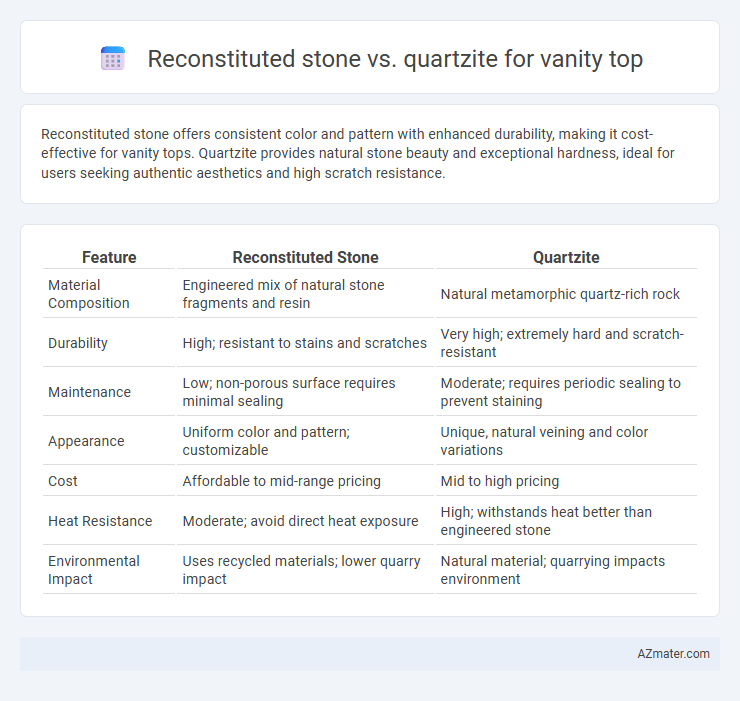Reconstituted stone offers consistent color and pattern with enhanced durability, making it cost-effective for vanity tops. Quartzite provides natural stone beauty and exceptional hardness, ideal for users seeking authentic aesthetics and high scratch resistance.
Table of Comparison
| Feature | Reconstituted Stone | Quartzite |
|---|---|---|
| Material Composition | Engineered mix of natural stone fragments and resin | Natural metamorphic quartz-rich rock |
| Durability | High; resistant to stains and scratches | Very high; extremely hard and scratch-resistant |
| Maintenance | Low; non-porous surface requires minimal sealing | Moderate; requires periodic sealing to prevent staining |
| Appearance | Uniform color and pattern; customizable | Unique, natural veining and color variations |
| Cost | Affordable to mid-range pricing | Mid to high pricing |
| Heat Resistance | Moderate; avoid direct heat exposure | High; withstands heat better than engineered stone |
| Environmental Impact | Uses recycled materials; lower quarry impact | Natural material; quarrying impacts environment |
Introduction: Reconstituted Stone vs Quartzite Vanity Tops
Reconstituted stone vanity tops combine crushed natural stone with resin binders, offering a versatile, durable, and cost-effective alternative to natural stone surfaces. Quartzite, a naturally occurring metamorphic rock, provides exceptional hardness and a unique, elegant appearance ideal for high-end vanity tops. Comparing reconstituted stone and quartzite involves evaluating factors such as durability, maintenance, aesthetic appeal, and price to determine the best material for bathroom applications.
Material Composition: Understanding Reconstituted Stone and Quartzite
Reconstituted stone is engineered from crushed natural stone particles mixed with resin and pigments, creating a consistent and customizable surface ideal for vanity tops. Quartzite is a natural metamorphic rock composed primarily of quartz sand grains tightly fused under heat and pressure, offering exceptional hardness and natural veining patterns. The combination of resin in reconstituted stone enhances stain and impact resistance, while quartzite's mineral composition provides superior scratch resistance and heat tolerance.
Aesthetic Appeal: Color and Pattern Variations
Reconstituted stone offers a wide range of color and pattern variations due to its engineered manufacturing process, allowing for consistent and customizable designs that mimic natural stone. Quartzite, a natural metamorphic rock, provides unique, organic patterns and subtle color shifts that create a luxurious and authentic look for vanity tops. The choice between reconstituted stone and quartzite depends on whether a homeowner prefers uniformity and tailored aesthetics or the distinctive, natural veining characteristic of quartzite.
Durability and Strength Comparison
Reconstituted stone offers consistent durability and resistance to stains and scratches due to its engineered composition, making it highly suitable for vanity tops in busy bathrooms. Quartzite, a natural metamorphic rock, provides exceptional strength and hardness, surpassing granite, and is highly resistant to heat and abrasion. Both materials ensure long-lasting performance, but quartzite's superior hardness makes it more durable against physical impacts and heavy daily use in vanity applications.
Maintenance Requirements for Vanity Tops
Reconstituted stone vanity tops require minimal maintenance, needing only regular cleaning with mild soap and water since they are non-porous and resistant to stains and scratches. Quartzite, while highly durable and resistant to heat, demands periodic sealing to prevent staining and etching, especially in bathroom environments exposed to harsh chemicals. Homeowners should consider the balance between quartzite's natural beauty and maintenance commitment versus the low upkeep and uniform appearance of reconstituted stone for long-term convenience.
Resistance to Stains, Scratches, and Heat
Reconstituted stone offers superior resistance to stains and scratches due to its non-porous composition and integrated resin, making it highly durable for vanity tops. Quartzite, a natural stone, is heat-resistant and harder than granite, but it is more porous and may require sealing to prevent stains. Both materials excel in heat resistance, but reconstituted stone provides more consistent protection against scratches and stains over time.
Cost Analysis: Reconstituted Stone vs Quartzite
Reconstituted stone typically costs between $50 to $150 per square foot, offering a more budget-friendly option compared to quartzite, which ranges from $60 to $200 per square foot. The lower production costs of reconstituted stone result in more consistent pricing and easier installation, whereas quartzite's natural extraction and transportation elevate its price. Long-term durability and resistance to heat and scratches may justify quartzite's higher upfront investment despite the initial cost difference.
Environmental Impact and Sustainability
Reconstituted stone vanity tops are made from crushed natural stone bonded with resin, allowing for the use of recycled materials and reducing quarrying impact compared to quartzite, which is a natural stone extracted through mining. Quartzite extraction leads to significant environmental disruption, including habitat destruction and high energy consumption during quarrying and processing. Reconstituted stone often has a smaller carbon footprint due to its manufacturing process and the possibility of incorporating recycled content, making it a more sustainable choice for environmentally conscious homeowners.
Installation Process and Flexibility
Reconstituted stone offers greater flexibility during installation due to its uniform composition, allowing for easier cutting and customized shapes compared to natural quartzite, which is more brittle and requires specialized tools. The installation process for reconstituted stone is generally faster and less labor-intensive since its consistent density reduces the risk of cracking or chipping. Quartzite, while extremely durable and aesthetically unique, demands expert handling and precise measurements, increasing installation time and complexity for vanity tops.
Which is Best for Your Vanity Top? Final Recommendations
Reconstituted stone offers a versatile, uniform surface with excellent stain and scratch resistance, ideal for budget-conscious projects requiring consistent appearance. Quartzite provides superior natural hardness and heat resistance, making it a premium choice for high-traffic vanity tops demanding durability and unique, natural patterns. For long-term investment and authentic stone aesthetics, quartzite is best, while reconstituted stone suits those prioritizing cost-effectiveness and low maintenance.

Infographic: Reconstituted stone vs Quartzite for Vanity Top
 azmater.com
azmater.com